Mingyuan Li
FOAM: A General Frequency-Optimized Anti-Overlapping Framework for Overlapping Object Perception
Jun 16, 2025Abstract:Overlapping object perception aims to decouple the randomly overlapping foreground-background features, extracting foreground features while suppressing background features, which holds significant application value in fields such as security screening and medical auxiliary diagnosis. Despite some research efforts to tackle the challenge of overlapping object perception, most solutions are confined to the spatial domain. Through frequency domain analysis, we observe that the degradation of contours and textures due to the overlapping phenomenon can be intuitively reflected in the magnitude spectrum. Based on this observation, we propose a general Frequency-Optimized Anti-Overlapping Framework (FOAM) to assist the model in extracting more texture and contour information, thereby enhancing the ability for anti-overlapping object perception. Specifically, we design the Frequency Spatial Transformer Block (FSTB), which can simultaneously extract features from both the frequency and spatial domains, helping the network capture more texture features from the foreground. In addition, we introduce the Hierarchical De-Corrupting (HDC) mechanism, which aligns adjacent features in the separately constructed base branch and corruption branch using a specially designed consistent loss during the training phase. This mechanism suppresses the response to irrelevant background features of FSTBs, thereby improving the perception of foreground contour. We conduct extensive experiments to validate the effectiveness and generalization of the proposed FOAM, which further improves the accuracy of state-of-the-art models on four datasets, specifically for the three overlapping object perception tasks: Prohibited Item Detection, Prohibited Item Segmentation, and Pneumonia Detection. The code will be open source once the paper is accepted.
CSPCL: Category Semantic Prior Contrastive Learning for Deformable DETR-Based Prohibited Item Detectors
Jan 28, 2025



Abstract:Prohibited item detection based on X-ray images is one of the most effective security inspection methods. However, the foreground-background feature coupling caused by the overlapping phenomenon specific to X-ray images makes general detectors designed for natural images perform poorly. To address this issue, we propose a Category Semantic Prior Contrastive Learning (CSPCL) mechanism, which aligns the class prototypes perceived by the classifier with the content queries to correct and supplement the missing semantic information responsible for classification, thereby enhancing the model sensitivity to foreground features.To achieve this alignment, we design a specific contrastive loss, CSP loss, which includes Intra-Class Truncated Attraction (ITA) loss and Inter-Class Adaptive Repulsion (IAR) loss, and outperforms classic N-pair loss and InfoNCE loss. Specifically, ITA loss leverages class prototypes to attract intra-class category-specific content queries while preserving necessary distinctiveness. IAR loss utilizes class prototypes to adaptively repel inter-class category-specific content queries based on the similarity between class prototypes, helping disentangle features of similar categories.CSPCL is general and can be easily integrated into Deformable DETR-based models. Extensive experiments on the PIXray and OPIXray datasets demonstrate that CSPCL significantly enhances the performance of various state-of-the-art models without increasing complexity.The code will be open source once the paper is accepted.
FuzzyLight: A Robust Two-Stage Fuzzy Approach for Traffic Signal Control Works in Real Cities
Jan 27, 2025Abstract:Effective traffic signal control (TSC) is crucial in mitigating urban congestion and reducing emissions. Recently, reinforcement learning (RL) has been the research trend for TSC. However, existing RL algorithms face several real-world challenges that hinder their practical deployment in TSC: (1) Sensor accuracy deteriorates with increased sensor detection range, and data transmission is prone to noise, potentially resulting in unsafe TSC decisions. (2) During the training of online RL, interactions with the environment could be unstable, potentially leading to inappropriate traffic signal phase (TSP) selection and traffic congestion. (3) Most current TSC algorithms focus only on TSP decisions, overlooking the critical aspect of phase duration, affecting safety and efficiency. To overcome these challenges, we propose a robust two-stage fuzzy approach called FuzzyLight, which integrates compressed sensing and RL for TSC deployment. FuzzyLight offers several key contributions: (1) It employs fuzzy logic and compressed sensing to address sensor noise and enhances the efficiency of TSP decisions. (2) It maintains stable performance during training and combines fuzzy logic with RL to generate precise phases. (3) It works in real cities across 22 intersections and demonstrates superior performance in both real-world and simulated environments. Experimental results indicate that FuzzyLight enhances traffic efficiency by 48% compared to expert-designed timings in the real world. Furthermore, it achieves state-of-the-art (SOTA) performance in simulated environments using six real-world datasets with transmission noise. The code and deployment video are available at the URL1
Fishers Harvest Parallel Unlearning in Inherited Model Networks
Aug 16, 2024

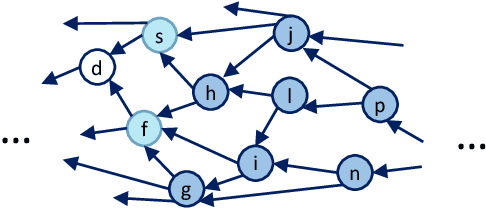

Abstract:Unlearning in various learning frameworks remains challenging, with the continuous growth and updates of models exhibiting complex inheritance relationships. This paper presents a novel unlearning framework, which enables fully parallel unlearning among models exhibiting inheritance. A key enabler is the new Unified Model Inheritance Graph (UMIG), which captures the inheritance using a Directed Acyclic Graph (DAG).Central to our framework is the new Fisher Inheritance Unlearning (FIUn) algorithm, which utilizes the Fisher Information Matrix (FIM) from initial unlearning models to pinpoint impacted parameters in inherited models. By employing FIM, the FIUn method breaks the sequential dependencies among the models, facilitating simultaneous unlearning and reducing computational overhead. We further design to merge disparate FIMs into a single matrix, synchronizing updates across inherited models. Experiments confirm the effectiveness of our unlearning framework. For single-class tasks, it achieves complete unlearning with 0\% accuracy for unlearned labels while maintaining 94.53\% accuracy for retained labels on average. For multi-class tasks, the accuracy is 1.07\% for unlearned labels and 84.77\% for retained labels on average. Our framework accelerates unlearning by 99\% compared to alternative methods.
Open-Vocabulary X-ray Prohibited Item Detection via Fine-tuning CLIP
Jun 16, 2024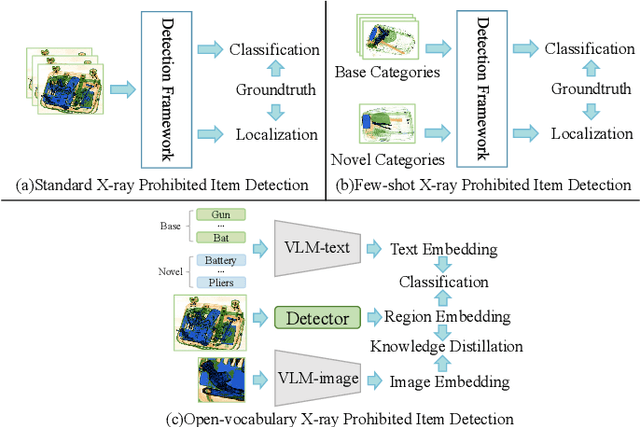
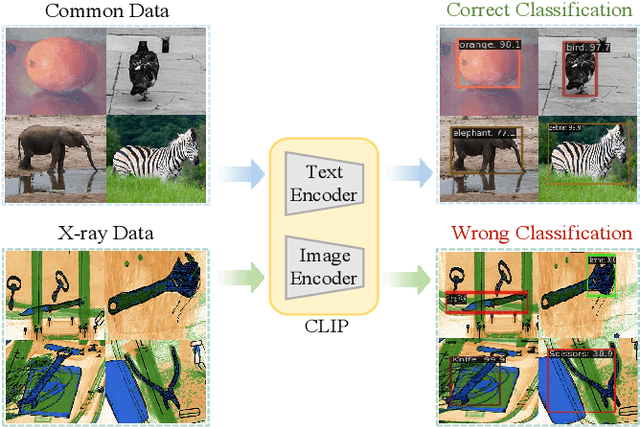
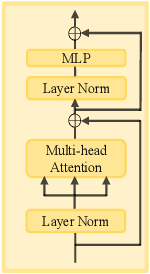
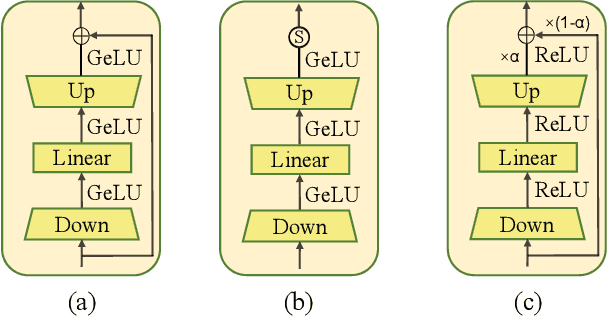
Abstract:X-ray prohibited item detection is an essential component of security check and categories of prohibited item are continuously increasing in accordance with the latest laws. Previous works all focus on close-set scenarios, which can only recognize known categories used for training and often require time-consuming as well as labor-intensive annotations when learning novel categories, resulting in limited real-world applications. Although the success of vision-language models (e.g. CLIP) provides a new perspectives for open-set X-ray prohibited item detection, directly applying CLIP to X-ray domain leads to a sharp performance drop due to domain shift between X-ray data and general data used for pre-training CLIP. To address aforementioned challenges, in this paper, we introduce distillation-based open-vocabulary object detection (OVOD) task into X-ray security inspection domain by extending CLIP to learn visual representations in our specific X-ray domain, aiming to detect novel prohibited item categories beyond base categories on which the detector is trained. Specifically, we propose X-ray feature adapter and apply it to CLIP within OVOD framework to develop OVXD model. X-ray feature adapter containing three adapter submodules of bottleneck architecture, which is simple but can efficiently integrate new knowledge of X-ray domain with original knowledge, further bridge domain gap and promote alignment between X-ray images and textual concepts. Extensive experiments conducted on PIXray and PIDray datasets demonstrate that proposed method performs favorably against other baseline OVOD methods in detecting novel categories in X-ray scenario. It outperforms previous best result by 15.2 AP50 and 1.5 AP50 on PIXray and PIDray with achieving 21.0 AP50 and 27.8 AP50 respectively.
MMCL: Boosting Deformable DETR-Based Detectors with Multi-Class Min-Margin Contrastive Learning for Superior Prohibited Item Detection
Jun 05, 2024Abstract:Prohibited Item detection in X-ray images is one of the most effective security inspection methods.However, differing from natural light images, the unique overlapping phenomena in X-ray images lead to the coupling of foreground and background features, thereby lowering the accuracy of general object detectors.Therefore, we propose a Multi-Class Min-Margin Contrastive Learning (MMCL) method that, by clarifying the category semantic information of content queries under the deformable DETR architecture, aids the model in extracting specific category foreground information from coupled features.Specifically, after grouping content queries by the number of categories, we employ the Multi-Class Inter-Class Exclusion (MIE) loss to push apart content queries from different groups. Concurrently, the Intra-Class Min-Margin Clustering (IMC) loss is utilized to attract content queries within the same group, while ensuring the preservation of necessary disparity. As training, the inherent Hungarian matching of the model progressively strengthens the alignment between each group of queries and the semantic features of their corresponding category of objects. This evolving coherence ensures a deep-seated grasp of category characteristics, consequently bolstering the anti-overlapping detection capabilities of models.MMCL is versatile and can be easily plugged into any deformable DETR-based model with dozens of lines of code. Extensive experiments on the PIXray and OPIXray datasets demonstrate that MMCL significantly enhances the performance of various state-of-the-art models without increasing complexity. The code has been released at https://github.com/anonymity0403/MMCL.
LIKO: LiDAR, Inertial, and Kinematic Odometry for Bipedal Robots
Apr 28, 2024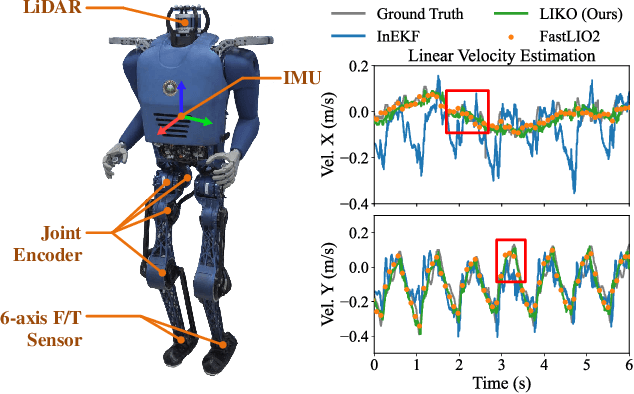
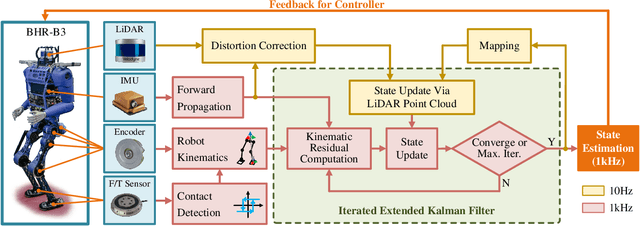
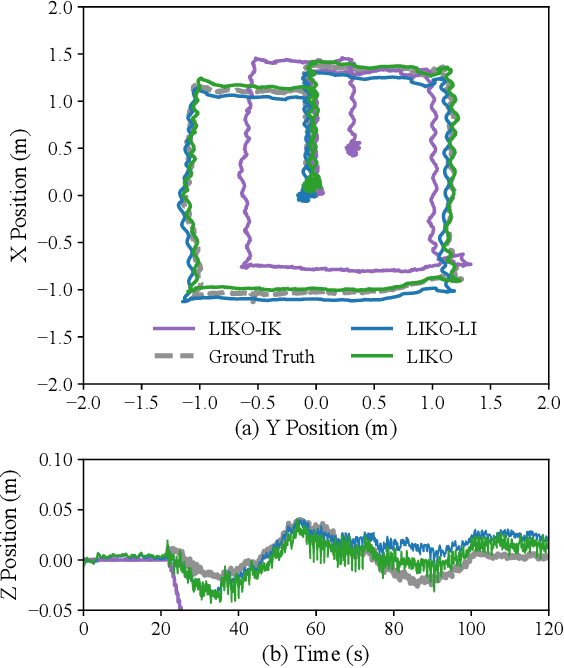
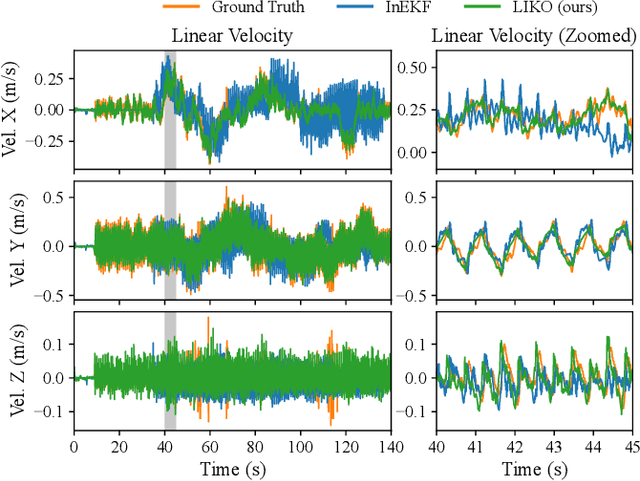
Abstract:High-frequency and accurate state estimation is crucial for biped robots. This paper presents a tightly-coupled LiDAR-Inertial-Kinematic Odometry (LIKO) for biped robot state estimation based on an iterated extended Kalman filter. Beyond state estimation, the foot contact position is also modeled and estimated. This allows for both position and velocity updates from kinematic measurement. Additionally, the use of kinematic measurement results in an increased output state frequency of about 1kHz. This ensures temporal continuity of the estimated state and makes it practical for control purposes of biped robots. We also announce a biped robot dataset consisting of LiDAR, inertial measurement unit (IMU), joint encoders, force/torque (F/T) sensors, and motion capture ground truth to evaluate the proposed method. The dataset is collected during robot locomotion, and our approach reached the best quantitative result among other LIO-based methods and biped robot state estimation algorithms. The dataset and source code will be available at https://github.com/Mr-Zqr/LIKO.
AO-DETR: Anti-Overlapping DETR for X-Ray Prohibited Items Detection
Mar 07, 2024



Abstract:Prohibited item detection in X-ray images is one of the most essential and highly effective methods widely employed in various security inspection scenarios. Considering the significant overlapping phenomenon in X-ray prohibited item images, we propose an Anti-Overlapping DETR (AO-DETR) based on one of the state-of-the-art general object detectors, DINO. Specifically, to address the feature coupling issue caused by overlapping phenomena, we introduce the Category-Specific One-to-One Assignment (CSA) strategy to constrain category-specific object queries in predicting prohibited items of fixed categories, which can enhance their ability to extract features specific to prohibited items of a particular category from the overlapping foreground-background features. To address the edge blurring problem caused by overlapping phenomena, we propose the Look Forward Densely (LFD) scheme, which improves the localization accuracy of reference boxes in mid-to-high-level decoder layers and enhances the ability to locate blurry edges of the final layer. Similar to DINO, our AO-DETR provides two different versions with distinct backbones, tailored to meet diverse application requirements. Extensive experiments on the PIXray and OPIXray datasets demonstrate that the proposed method surpasses the state-of-the-art object detectors, indicating its potential applications in the field of prohibited item detection. The source code will be released at https://github.com/Limingyuan001/AO-DETR-test.
Decentralized Federated Unlearning on Blockchain
Feb 26, 2024



Abstract:Blockchained Federated Learning (FL) has been gaining traction for ensuring the integrity and traceability of FL processes. Blockchained FL involves participants training models locally with their data and subsequently publishing the models on the blockchain, forming a Directed Acyclic Graph (DAG)-like inheritance structure that represents the model relationship. However, this particular DAG-based structure presents challenges in updating models with sensitive data, due to the complexity and overhead involved. To address this, we propose Blockchained Federated Unlearning (BlockFUL), a generic framework that redesigns the blockchain structure using Chameleon Hash (CH) technology to mitigate the complexity of model updating, thereby reducing the computational and consensus costs of unlearning tasks.Furthermore, BlockFUL supports various federated unlearning methods, ensuring the integrity and traceability of model updates, whether conducted in parallel or serial. We conduct a comprehensive study of two typical unlearning methods, gradient ascent and re-training, demonstrating the efficient unlearning workflow in these two categories with minimal CH and block update operations. Additionally, we compare the computation and communication costs of these methods.
 Add to Chrome
Add to Chrome Add to Firefox
Add to Firefox Add to Edge
Add to Edge